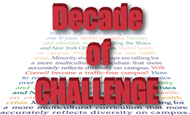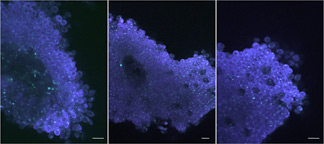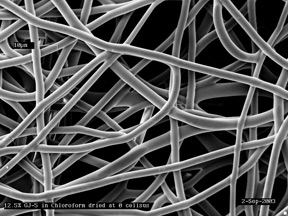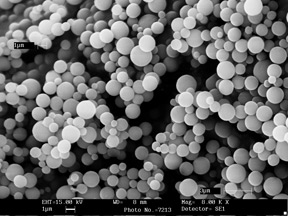From developing artificial skin to relieving chronic pain in elderly, growing intercampus collaborations improve quality of life
By Lauren Gold

C.C. Chu is a professor in the Department of Fiber Science and Apparel Design and the Biomedical Engineering Program who develops biomaterials in his laboratories on Cornell's Ithaca campus. He is an academic, not a clinician.
Roger Yurt is an attending surgeon at Weill Cornell Medical College (WCMC) in New York City, where he directs a center for burn victims. He is a professor of surgery, and a clinician.

Although they work 250 miles apart, the two are closely collaborating on an artificial skin project, which derives from a large family of therapeutic biodegradable biomaterials recently developed in Chu's lab. Other biomaterials from the same family have been tested as drug-eluting (releasing) stents and vascular grafts for vascular diseases, hydrogels for gene therapy or to treat cancer, and even a fabric that could replace cotton swabs for collecting DNA evidence in crime scenes.
"The goal of my research is to use fibers and polymers and their engineering to save human life and improve quality of life," Chu says. He has over 20 patents for his innovations toward that goal. And while he spends most of his time distant from his medical counterparts in New York City, he is closely linked to their work.
Chu is one of dozens of researchers on Cornell's Ithaca campus involved in a cross-campus research partnership. On both the Ithaca and WCMC campuses, researchers are paying more attention to ways their work might benefit from the added expertise of colleagues on the other end of the laboratory-to-bedside pipeline. Tools like videoconferencing and the Cornell campus-to-campus bus service (which has plans to improve accessibility over the coming months) are making the process easier. And the administration is fostering such collaborations with seed grants and other support.


"Science is advancing to be more integrative across the disciplines of the two campuses," says Stephen Kresovich, vice provost for the life sciences and professor of plant breeding and genetics on the Ithaca campus. Facilitating cross-campus collaboration "just makes good sense, intellectually and academically. But it will have its own set of unique challenges."
Simple as the concept is, the reality is far more complicated. Between logistical hurdles and administrative tangles (the four- to five-hour drive, high airline fares and difficulty finding affordable accommodations in New York City), creating a true culture of cross-campus collaboration is a tall order. Then there are additional challenges in smoothing the interface for graduate students working on both campuses, identifying research areas with the greatest potential, and writing research funding proposals.
Last year, Provost Biddy Martin and WCMC Dean and Provost Antonio Gotto established a steering committee of faculty leaders to come up with a way to counter many of these challenges. Their findings, reported this year, include a list of four primary research areas in which the two campuses have what Kresovich calls "synergies of expertise": bioengineering, nanomedicine and systems biology; diagnostics and experimental therapeutics; global health and infectious diseases; and cancer-related cell biology.
"We defined areas of common interest across the two campuses," says David Hajjar, a Frank Rhodes Professor, vice provost of WCMC, dean of the Graduate School of the Medical Sciences and member of the committee. "Tony Gotto and I felt very strongly that we wanted to focus on areas that we really wanted to work on at the medical college. We did not identify areas that we didn't think we would develop on both campuses."
Seed grants, meanwhile, have been established to support such collaborations ($400,000 is available for distribution in 2007). For the first time, the university's capital campaign includes a designated fund for joint projects. And the two campuses also are working together to raise $300 million to fund increased collaboration.
As the administrative problem-solving continues, more projects like those conceived by Chu and Yurt are gaining prominence --- and momentum.
Watt Webb, Cornell professor of applied physics and the S.B. Eckert Professor in Engineering, is leading one of the largest efforts: an extensive group of collaborative projects involving multiphoton microscopy (MPM), a technique pioneered in his lab. The projects aim to combine MPM with medical endoscopies to provide images of tissue in situ and in real time, using microscopic fluorescence and harmonic excitation.
Creative collaborations have been common throughout Webb's career, but many of the current projects with WCMC began after he spent two 12-hour days touring the medical school campus and meeting with physicians to explore potential areas of collaboration.
Immediately, Webb says, he was impressed with the clinicians' knowledge. "I could briefly explain multiphoton microscopy and how it works to them, and they understood me and could ask the right questions very efficiently. And then they could tell me what they were doing, what their problems were, and how they would like to benefit from MPM in their medical endoscopy. I was absolutely amazed by the effective communication with those guys."
Webb expected two or three of the several dozen physicians to have needs that could be addressed with the MPM. Instead, he says, he found strong interest and viable suggestions from nearly everyone.
The result: a very long list of potential innovations. Enough to make his voice go hoarse, in fact, before he can recite all of them.
From the list, Webb's lab has chosen the ideas most likely to benefit medicine in the near future. Among the most promising: designing endoscopes fitted with optical fiber to illuminate a laser scanning multiphoton microscope, potentially aiding in the diagnosis and treatment of bladder cancer. His laboratory is currently working on this with Douglas Scherr, assistant professor of urology and clinical director of urological oncology at WCMC, as well as Chris Xu, assistant professor of applied and engineering physics, Warren Zipfel, associate professor of biomedical engineering, and others. Prototype instruments are under development. The device could eliminate the need for traumatic and costly periodic biopsies of the bladder wall for assessing progress during chemotherapy; it also anticipates the development of similar instruments for colonoscopies and other endoscopic procedures.
On another front, Webb is working with Fred Maxfield, WCMC's Israel Rogosin Professor of Biochemistry, Gunnar Gouras, associate professor of neurology and neuroscience at WCMC, and colleagues to apply MPM and fluorescence correlation spectroscopy (FCS) to study protein folding and aggregation in such neurodegenerative diseases as Alzheimer's and Parkinson's. These studies, which use MPM to image brain tissue and FCS for enzyme function and molecular aggregation, could give researchers a stronger understanding of what causes these diseases and how to mitigate them.
Ithaca-New York collaborations are not only in the realm of the super-high-tech. Another collaboration, the Cornell Institute for Translational Research on Aging (CITRA), is deeply rooted in the idea that the campuses' resources complement each other in unique ways. In CITRA's case, the resources include theoreticians and social scientists in Ithaca, research clinicians from the Division of Geriatrics and Gerontology at WCMC and researchers at the Psychiatric Division of the Cornell Institute for Geriatric Psychiatry in Westchester County.
CITRA, funded by a $1.9 million grant from the National Institute on Aging, is a broad collaboration to study issues related to aging -- and translating that research to real-world solutions for the elderly.
"We realized that we had significant but incomplete strengths in the field of gerontology on both campuses," says Karl Pillemer, CITRA co-director and Cornell professor of human development. "The Ithaca campus had the social gerontology, sociological and psychological aspects; Weill had clinical research geriatricians and gerontological psychiatry. Our goal was to merge some of the social science expertise in Ithaca with the clinical expertise of Weill."
Since its formal inception in 2003, CITRA researchers have examined the link between chronic pain and depression in the elderly, end-of-life preferences among members of New York's Hindu community and social isolation among elderly African-Americans, while working extensively with community-based programs in New York City to improve services.
As the list of cross-campus projects grows -- and already there are dozens -- researchers see benefits emerging with a host of innovations on the forefront.
"The integration of basic science and engineering with clinical science is a necessity for those who want to take academic research lab findings to the real world," says Chu. "This partnership between Ithaca and Weill Cornell campuses provides Cornell scientists like me with the golden opportunity to take academic innovations closer to clinical reality for touching someone's real life."
With all its obstacles and hurdles, the partnership is still far from ideal. But the message, says WCMC Vice Provost Hajjar, is simple.
"The administration gets it," he says. "We recognize the issues and current inadequacies, and we will work hard to address them." Including, he adds, the top two concerns: transportation and housing.
"The rest won't work without that piece," he says. "But the president [and senior administrators] are committed to solving these issues. We are working to get this done. We understand."
Fast track to collaboration
Communications between Cornell's Ithaca and New York campuses got a little smoother this year, thanks to a patchwork of new and existing fiber-optic cables and increased tech support. The improvements are aimed at helping researchers conduct videoconferences, share high-quality images and work together as if they were just a few steps apart.
In May, the university approved a plan for upgrades, new equipment, new personnel, and a strategy that includes using the National LambdaRail, a network dedicated to serving the research community nationwide. "This allows us to have a huge amount of bandwidth for information transfer between the two campuses," said Ed Kiefer, assistant director of voice and data engineering.
"We're providing the people support to allow them to work together," added information technology assistant director Tom Every. "When these researchers walk into a room they've got that support. They just sit down and start working together."
We invite your comments on this story and will post your thoughts here. Only signed e-mail will be considered.
Media Contact
Get Cornell news delivered right to your inbox.
Subscribe